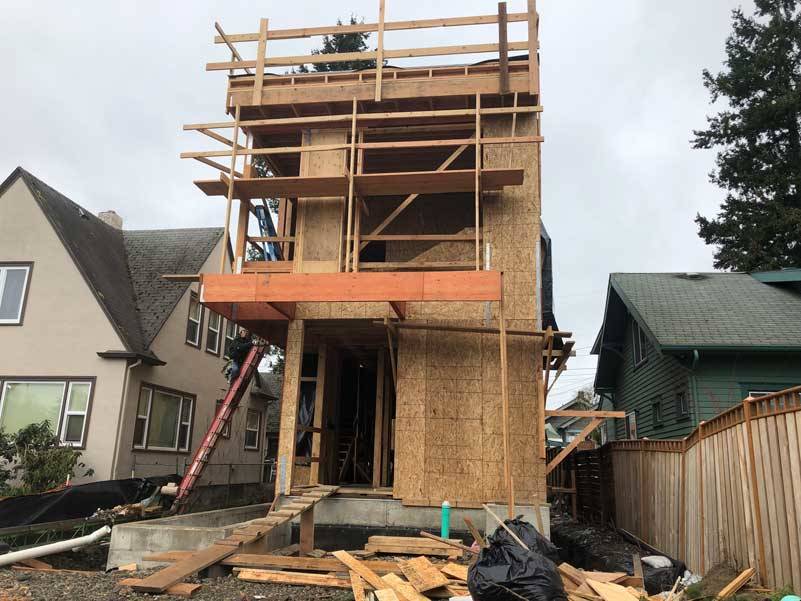By Morf Morford
Tacoma Daily Index
Some call it Simcityism, some call it Minecraftsman, McUrbanism, Fast-casual Architecture, Contemporary Contempt, Blandmarks, LoMo (low modern), or even Spongebuild Squareparts, but whatever you call it, and however much you might love or hate it, this design theme has taken over our streets and urban landscapes.
In our era we have multiple pressing, and often contradictory priorities; yes we need more housing.
Our population is growing and will certainly continue to do so.
Building costs and constrictions are also growing and will also certainly continue to do so.
Affordable, attractive and marketable housing is the ever shifting target in large scale housing.
And as a cynic might put it, of those three characteristics, pick two.
Or one.
The situation has gotten so out of hand in Tacoma that there is an unofficial contest for the ugliest building in Tacoma, old or new.
There are a few older buildings that are bad or ugly, but the real, and apparently active, competition seems to be among the new, or even currently under construction architectural contributions to our city’s landscape.
Of course I use the term “architectural contributions” generously.
Most of these buildings look like they were designed by accountants, with an eye on costs more (far more in most cases) than on appeal or livability.
In other words, they were built with little, if any, regard for those of us who might look at or live with their creations.
But as one designer put it, nothing is an excuse for bad design.
Even prosperous neighborhoods seem to have these “fast-casual” boxes hovering over them.
I hesitate to even call them housing units – they are more like economic units, designed to take advantage of various tax abatement programs more than to function as housing – or even as a contribution to a community landscape or skyline.
I’ve been in several of these buildings. They generally fit on a spectrum between bland and ugly – but some are downright claustrophobic if not uncomfortable.
The design scheme of the day seems to be 1990s budget hotel.
And it’s not just the visual aspect.
As I write this, a continuing news story is of the collapsing condominium towers in Florida.
One commentator wrote of “the age of condominiums” – he didn’t mean the chronological age of any given building but the era that gave us the quick fix to the housing crisis of a generation ago.
As we now see, the cheap housing solution of a pervious era is a moral and legal liability that will far outlive its few years of usable housing.
The lawsuits and legal wrangling will go on for years, even decades. Almost certainly longer than the projected life span of the buildings themselves.
In fact one of the ironies is that for many modern buildings an acceptable life-span of about 40 years is close to the industry standard – that’s barely longer than the usual home mortgage.
Housing is the ultimate investment- whether you are talking about individuals, neighborhoods or larger communities.
In many ways, we are what we build and we are what we leave behind.
But for now, we have gone from “Why on earth would anyone live in that building?” – which was bad enough when it was a cheap last resort, but now it’s an expensive eyesore and still inhabited – or at least invested in. (Many of these “units” have been purchased, but stay empty).
The tragedy is that these buildings don’t need to be tacky, or ugly or bland or a hazard to their occupants.
They could be a tribute to their companies, a monument to their times.
They could stand, like the row houses of London or the Victorian classics of San Francisco as living monuments to their time and culture.
As one designer put it, regarding contemporary design “the less beige, the better”.
As a color there’s noting wrong with beige, but beige is bland, and the message we seem to be broadcasting to the world at large is that bland is the best we can do.
But we all know that is not true.
Will many of the buildings built in the past 40 years or so be as venerated as the craftsman homes of 80-100 years ago?
Probably not.
In fact how many of them will even still be standing a generation from now?
I love walking in neighborhoods with a coherent and consistent historic design theme.
It could be a bungalow neighborhood or a Parisian boulevard, but there is something remarkable about seeing the same walls and urban settings that were seen by residents a hundred or two hundred or even, in older cities, eight hundred years ago.
Too many of our current housing projects seem to be built with the mind set of a cell phone contract or even a meal plan with a set expiration date.
Too many of our current homes reflect the class, social and economic divisions that seem to define us; single family homes are ever larger and apartment/condominium units seem to be ever smaller.
And they all seem to look like every other housing unit.
I’ll admit to being biased here, but I just don’t like buildings that could be anytime or anywhere – especially those literally intended to be semi-disposable.
Where are the buildings designed specifically for people here? For the places, views and seasons uniquely us?
But besides affordability, home buyers, especially younger (and some older) ones want something else; they want character and mobility – and they don’t mean cars.
Walkability, bike lanes, a sense of community and mass transit are high priorities for many current buyers.
A solid (both literally and financially) investment is also preferred.
Those standards aren’t that difficult to meet are they?






